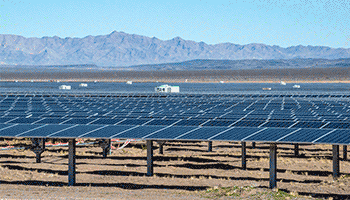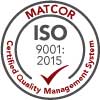The US is constructing an increasing number of very large solar power generation farms, which brings about the question–what about corrosion? This new article explores solar farm steel pile corrosion. Do the buried galvanized steel piles supporting solar arrays meet service life requirements?

Big Footprint
We continue to construct an increasing number of solar power generation facilities. The United States plans even more as it continues to pursue policies encouraging renewable energy development.
The economies of scale make these facilities more competitive with other electrical generation technologies. These utility-scale solar farms have a capacity of anywhere from 1 MW to 1000+ MW. One feature of these solar farms is their physical footprint. The average solar farm requires 6-8 acres of land to support the tens of thousands of PV cells necessary to generate electricity at this scale.
For example, the Mammoth Solar Farm project in northern Indiana, once completed, will have a generation capacity of 1650 MW. And it will cover an area of 13,000 acres and use more than 2.85 million solar panels. This is the largest project in the US and should become fully operational in 2024.
Steel Piles That support Solar Arrays: What About Corrosion?
Given these facilities’ size, cost, and anticipated service life, a fair question to ask during the design phase is: what about corrosion? Specifically, the buried support structures that hold the solar arrays in place.
Typically, construction crews drive or screw galvanized steel piles into the soil to support the solar panels’ frames. Galvanized steel piles generally have a good service life in most environments for this application. However, as with all steel structures, they are subject to corrosion. Eventually, steel pile corrosion will adversely affect the support structure’s integrity.
Therefore, solar farm operators should consider the impact of corrosion on the service life of the galvanized piles during the project’s design phase.
Start with The Piling Details
The first step in the corrosion assessment process is to know your piles.
Any sizable solar farm project will require thousands of steel piles. The type of pile and the galvanizing thickness significantly impacting the project cost.
Unfortunately, structural engineers often do not consider corrosion when sizing the piles. They are keenly aware of loading concerns and select the pile to use based on a detailed soil load-bearing analysis and wind load analysis. They consider how big and how deep the piles need to be to support the predicted mechanical loads. This is often the only consideration. As a result, any conversation regarding corrosion is often relegated to – don’t worry, the piles are galvanized.
How Corrosive is the Environment?
But even galvanized piles are subject to corrosion, and in a highly corrosive environment, that service life might be much lower than expected. Therefore, additional corrosion mitigation measures, such as cathodic protection, might be warranted in some cases.
Given the massive footprint covering hundreds to thousands of acres these sites require, a thorough corrosion assessment for the entire area is warranted.
Typically, Geotech firms are contracted early in the project to perform detailed soil testing across these sites. This testing provides the requisite soil load capacity data to design the structural supports properly. While performing the site-wide testing, these firms will often perform some representative soil resistivity testing. While these sample soil resistivity tests may indicate the soil’s corrosiveness, they are often insufficient to evaluate correctly.
MATCOR Study: A Soil Testing Analysis
In one study performed by MATCOR, a comprehensive soil testing analysis found that much of a solar farm was in moderately corrosive soils. Still, a significant part of the facility was in very corrosive soils. In addition, the service life calculations varied significantly for the piles depending on their location within the solar farm. Estimated life ranged from 17 years to 30+ years.
Another factor in the service life calculations is the anticipated degradation of the piles during installations. The impact on the zinc coating can vary significantly depending on the soil characteristics.
MATCOR provides comprehensive soil resistivity testing services.
Steel Pile Corrosion: How Long Will the Steel Piling Last?
The first phase of the service life of driven steel piles is the outer zinc layer of the galvanized steel pile. Zinc acts as both a coating and a galvanic anode. As the zinc layer is consumed, the underlying steel substrate is exposed. Therefore, the estimated service life, in simple terms, is the anticipated service life of the zinc coating plus the expected service life of the steel substrate.
We define the service life for solar structural galvanized steel piles as some allowable percentage thickness loss before compromising the pile’s integrity.
There are a lot of factors that affect the pile’s corrosion rate, including:
- Presence of copper grounding bonded to the pile
- Degradation of the zinc coating during the driving of the pile
- Differential soil resistivity strata
- Differential oxygen levels/aeration
- Location of the water table in the area of buried piles
One of the biggest drivers of accelerated corrosion for piles is the presence of copper grounding. When steel piles are connected to a copper grounding grid, their service life can be significantly reduced as the zinc coating layer and the underlying steel substrate act as galvanic anodes. This can be very impactful in low soil resistivity environments.
Significant Steel Pile Corrosion Can Occur in as Little as Five Years
In some extreme cases, corrosion of the galvanized piles can be structurally significant in less than five years of service. In most cases, the service life in corrosive environments can be anywhere from 10-25 years of service. A service life of more than 50 years in low-corrosivity soils might be achievable.
Solar farms are a growing part of our electrical generation portfolio and will continue to see substantial investments in the next several decades. Given the footprint and cost of these facilities, design engineers should seek corrosion assessments from qualified corrosion engineering firms such as MATCOR to confirm that the piling systems used to support the solar arrays meet the facilities’ service life requirements.
If you need assistance with galvanized steel pile corrosion protection, please contact us. We will respond by phone or email within 24 hours. For immediate assistance, please call +1-215-348-2974.
Contact a Corrosion Expert





